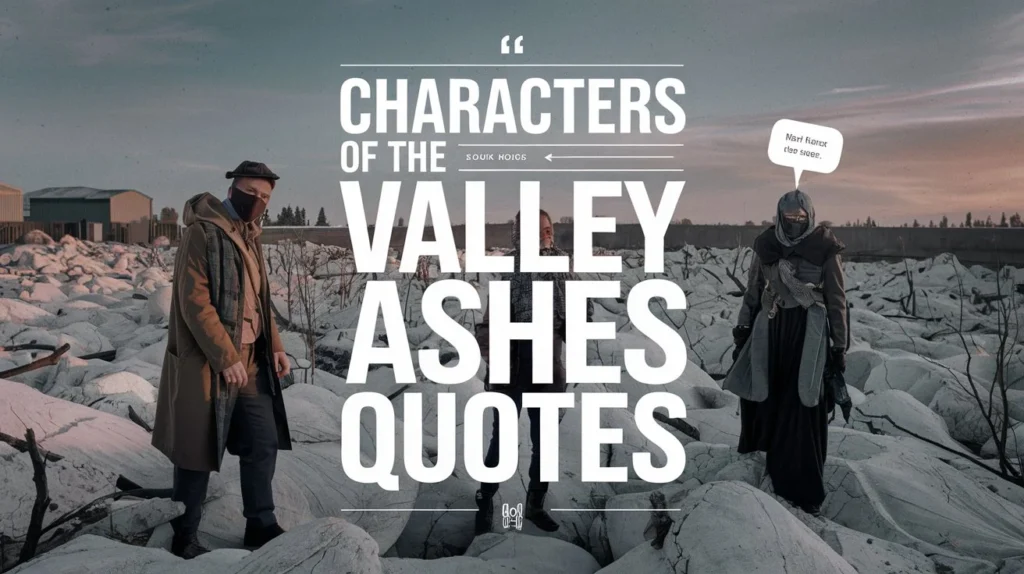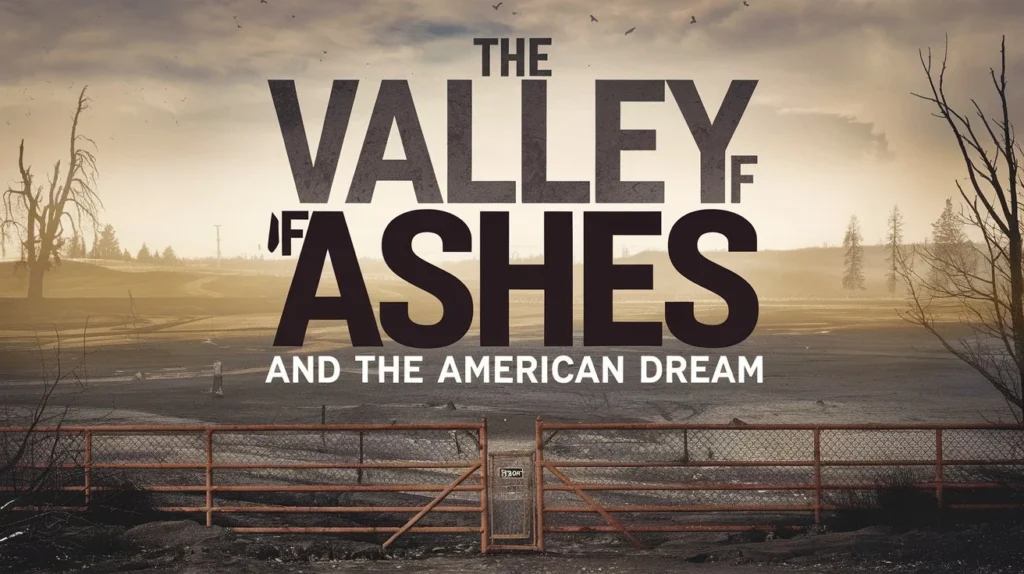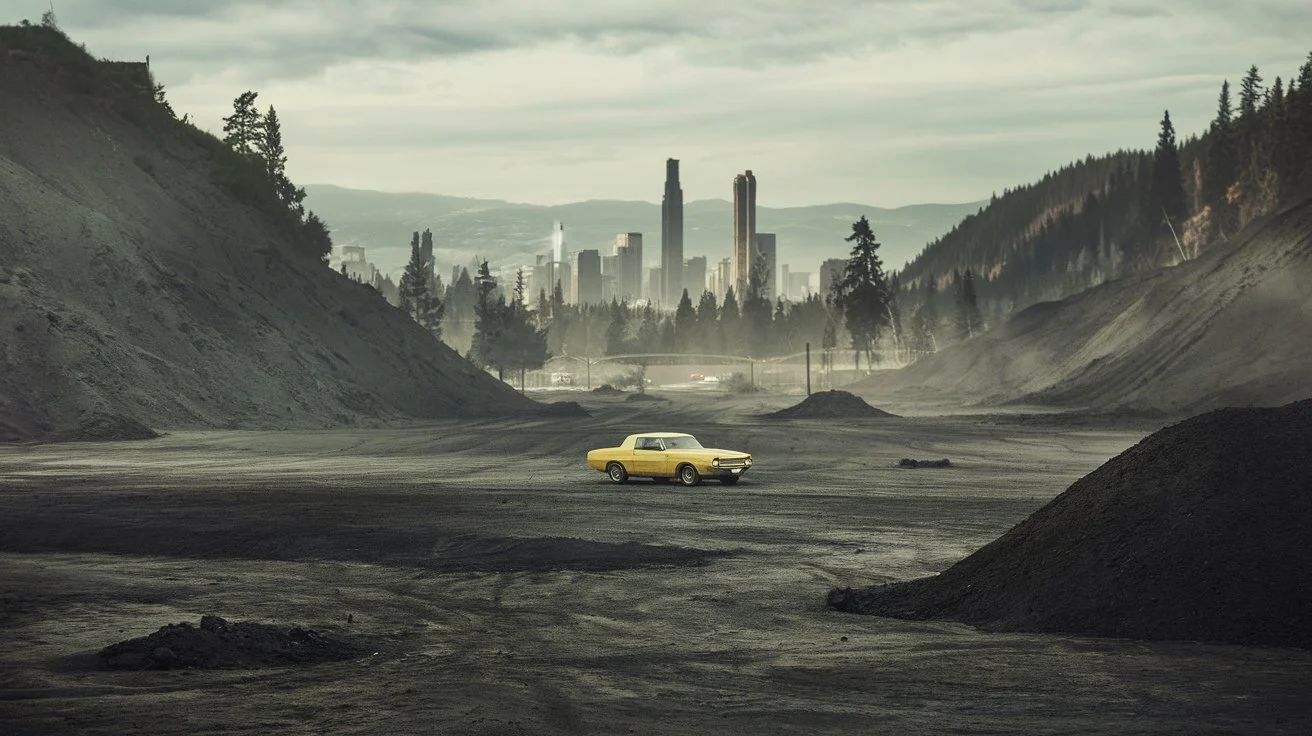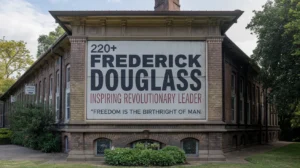In F. Scott Fitzgerald’s classic novel The Great Gatsby, the Valley of Ashes serves as a potent symbol of moral and social decay. It contrasts sharply with the opulence of East Egg and the vibrancy of Gatsby’s parties. Through its portrayal, Fitzgerald offers a critique of the American Dream and the corruption that often accompanies the pursuit of wealth.
In this blog post, we’ll delve into a collection of quotes that capture the essence of the Valley of Ashes, reflecting on its significance and impact on the narrative. Each quote provides insight into the novel’s themes and characters, revealing the stark reality behind the glittering facade of the 1920s.
The Desolate Landscape of the Valley of Ashes🌪️
- “The Valley of Ashes was a gray, desolate place where the dust lay heavily on everything.”
- “In the Valley of Ashes, nothing was vibrant; even the color seemed to have faded away.”
- “The smoke and dust created a constant veil, obscuring the once-lively hopes of the residents.”
- “Amidst the ruins, the remnants of past glories were almost indistinguishable.”
- “The sky over the Valley of Ashes was a pale reflection of the squalor below.”
- “It was a place where ambition turned to ash, and the dreams of many lay scattered.”
- “The valley was a graveyard of forgotten dreams, where the dust spoke louder than words.”
- “The air in the Valley of Ashes was thick with the stench of lost opportunities.”
- “In this bleak landscape, hope was as elusive as a fading mirage.”
- “Everything in the Valley of Ashes seemed to be consumed by a relentless grayness.”
- “The grayness of the Valley of Ashes was a constant reminder of its despairing condition.”
- “The valley’s dusty streets and abandoned structures told a story of neglect.”
- “The bleak setting of the Valley of Ashes contrasted sharply with the glittering world of East Egg.”
- “Every corner of the valley seemed to be shrouded in a gloomy haze.”
- “The incessant gray of the valley felt like a heavy blanket of misfortune.”
- “The dust settled on everything, making even the most ordinary objects look forlorn.”
- “The empty roads of the Valley of Ashes seemed to echo the void in its residents’ lives.”
- “The valley was a testament to the economic and social decay of the era.”
- “The mournful silence of the valley was as penetrating as its gray landscape.”
- “The endless expanse of ash served as a symbol of the dreams that had turned to dust.”
Characters of the Valley of Ashes🏚️

- “The inhabitants of the Valley of Ashes were marked by their resignation and grit.”
- “Among the characters who roamed the valley, despair seemed to be the common thread.”
- “In the Valley of Ashes, George Wilson exemplified the bleakness of the environment.”
- “Myrtle’s frenzied attempts to escape the Valley of Ashes were a tragic reflection of her yearning.”
- “Tom Buchanan’s visit to the valley highlighted his disdain for its inhabitants.”
- “Nick Carraway’s description of the Valley of Ashes was as telling as it was revealing.”
- “The characters in this desolate land were often caught between hope and hopelessness.”
- “Myrtle’s existence in the valley was a sharp contrast to the luxury of her lover’s world.”
- “George Wilson’s deterioration mirrored the decay of the Valley of Ashes.”
- “The presence of Tom and Myrtle in the Valley of Ashes underscored the moral and social divide.”
- “Myrtle’s desperate behavior in the valley revealed her unfulfilled dreams and desires.”
- “George Wilson’s poverty in the valley was a stark contrast to the wealth of Tom Buchanan.”
- “The struggles of the valley’s residents highlighted the social and economic disparities.”
- “The hopelessness of the valley seemed to seep into the lives of its inhabitants.”
- “Nick’s observations of the Valley of Ashes were filled with sympathy for its characters.”
- “The moral decay of the Valley of Ashes was mirrored in the lives of those who lived there.”
- “Tom Buchanan’s cruelty towards the residents was a reflection of his indifference to their plight.”
- “The relationship between Myrtle and Tom was a tragic element of the valley’s dark landscape.”
- “The influence of the valley on its residents was one of desperation and resignation.”
- “Nick’s awareness of the Valley of Ashes underscored the moral and social contrasts in the novel.”
Symbolism in the Valley of Ashes🌫️
- “The gray ash in the valley symbolized the moral decay of society.”
- “The valley itself represented the collapse of the American Dream.”
- “The dust that blanketed the valley was a metaphor for the spiritual and social barrenness.”
- “The valley’s desolation was a reflection of the disillusionment of the era.”
- “The ashes stood as a stark contrast to the glamour of Gatsby’s world.”
- “In the valley, emptiness was as pervasive as the gray landscape.”
- “The Valley of Ashes embodied the corruption and decay of the Jazz Age.”
- “The darkness of the valley was a symbol for the moral darkness within the characters.”
- “The valley served as a warning about the perils of unrestrained wealth and ambition.”
- “The valley’s bleakness underscored the incompatibility of dreams with reality.”
- “The ashes in the valley symbolized the fading hopes of its inhabitants.”
- “The desolate state of the valley was a visual metaphor for the corruption of the time.”
- “The valley’s drab appearance reflected the moral and social decay of the era.”
- “The contrast between the valley and Gatsby’s world highlighted the moral divide.”
- “The valley served as a commentary on the illusions of the American Dream.”
- “The gritty reality of the valley was a symbol for the failures of the Jazz Age.”
- “The ash was a metaphor for the decay of the American dream.”
- “The valley’s bleakness acted as a mirror for the characters’ own moral decline.”
- “The symbolism of the Valley of Ashes pointed to the emptiness behind the era’s prosperity.”
- “The desolate landscape of the valley highlighted the moral cost of the era’s excess.”
The Valley of Ashes in Key Scenes🚗
- “The scene in the Valley of Ashes where Gatsby and Daisy’s relationship is exposed highlights its bleakness.”
- “Tom’s brutal confrontation with George Wilson in the Valley is a moment of cruelty and reality.”
- “Myrtle’s death by car in the valley is a tragic reflection of her desperation.”
- “The valley serves as a backdrop for key revelations about characters’ true natures.”
- “Nick’s first encounter with the Valley of Ashes sets the tone for the novel’s social commentary.”
- “The disappearance of the valley’s hope is poignantly depicted in its desolate scenes.”
- “Gatsby’s tragic attempt to bring Daisy to the Valley of Ashes shows the clash between idealism and reality.”
- “Tom’s cruelty towards George in the Valley underscores the moral and social decay.”
- “The valley highlights the contrast between the rich and the not rich through its gritty imagery.”
- “The valley acts as a mirror to the characters’ own moral and emotional states.”
- “The dramatic moment of Myrtle’s death underscores the harsh reality of the Valley of Ashes.”
- “Tom’s visit to the Valley of Ashes reveals his disdain for the lower classes.”
- “The scene of George Wilson’s confrontation with Gatsby marks a turning point in the novel.”
- “The valley’s bleak setting amplifies the tension between the characters.”
- “The striking imagery of the Valley of Ashes during the climactic scenes is both poignant and powerful.”
- “Nick’s narrative of the Valley of Ashes provides a critical view of the era’s moral landscape.”
- “The valley’s depressing atmosphere is a background for the novel’s tragic moments.”
- “The desolate nature of the valley underscores the futility of Gatsby’s dreams.”
- “Scenes set in the Valley of Ashes are marked by a sense of inevitability and despair.”
- “The valley’s despairing environment serves as a stage for the novel’s darker themes.”
Imagery and Atmosphere of the Valley of Ashes🌪️
- “The valley is depicted with vivid imagery that emphasizes its desolation.”
- “The gray sky and dust create a melancholic atmosphere over the valley.”
- “The stifling air and asphalt streets contribute to the oppressive atmosphere of the valley.”
- “The visual of the valley’s dust and ashes evokes a sense of stagnation and decay.”
- “The desolate landscape of the valley mirrors the emotional and psychological states of its inhabitants.”
- “The asphalt and grayness create a bleak visual metaphor for the loss of hope.”
- “Imagery of broken machinery and discarded objects reflects the disintegration of the American Dream.”
- “The oppressive atmosphere of the valley underscores the socio-economic divide between characters.”
- “The valley’s sterile landscape serves as a contrast to the vibrant settings of other locations.”
- “The darkness and dust of the valley create a gloomy backdrop for the novel’s dramatic moments.”
- “The gritty details of the Valley of Ashes highlight the harshness of the era.”
- “The bleak imagery of the valley sets a somber tone for the novel’s events.”
- “The dusty streets and crumbling buildings contribute to the valley’s depressing atmosphere.”
- “The desolate environment of the valley serves as a contrast to the luxury of other settings.”
- “The visual portrayal of the valley underscores its role as a symbol of moral decay.”
- “The harsh imagery of the valley enhances the novel’s critique of the American Dream.”
- “The dust that covers everything in the valley creates a sense of bleakness and despair.”
- “The valley’s monotonous landscape reflects the routine and hopelessness of its inhabitants.”
- “The grimy streets of the valley are depicted with vivid imagery to emphasize their deterioration.”
- “The valley’s gloomy setting enhances the novel’s themes of disillusionment and decay.”
Social Critique Through the Valley of Ashes🌠
- “The Valley of Ashes critiques the materialism and superficiality of the Jazz Age.”
- “The decay in the valley symbolizes the moral decline beneath the era’s facade.”
- “Fitzgerald uses the valley to expose the social inequality and exploitation prevalent in society.”
- “The Valley of Ashes serves as a commentary on the disillusionment of the American Dream.”
- “The disparity between the valley and the opulent neighborhoods reflects the social divide of the time.”
- “The desolation of the valley highlights the emptiness behind the era’s glitz and glamor.”
- “The exploitation of the valley’s inhabitants serves as a critique of the era’s social dynamics.”
- “Fitzgerald’s portrayal of the valley emphasizes the corruption and moral decay of the wealthy.”
- “The valley’s bleakness is a symbol for the failure of the American Dream.”
- “The contrast between the valley and other settings underscores the social and economic disparities.”
- “The Valley of Ashes acts as a mirror to the moral failings of the Jazz Age.”
- “Fitzgerald’s depiction of the valley criticizes the materialistic pursuits of the era.”
- “The valley highlights the moral and social decay hidden behind the facade of wealth.”
- “The valley’s desolation is a reflection of the social inequalities of the time.”
- “The crumbling infrastructure of the valley serves as a metaphor for societal decline.”
- “The inhabitants of the valley are portrayed as victims of the era’s economic injustices.”
- “The valley’s stark contrast to the affluent areas underscores the moral bankruptcy of the time.”
- “Fitzgerald uses the valley to critique the illusion of prosperity and success.”
- “The bleakness of the valley exposes the underbelly of the era’s cultural values.”
- “The Valley of Ashes serves as a powerful critique of the American Dream’s failure.”
Themes Reflected in the Valley of Ashes💔
- “The theme of decay is central to the depiction of the Valley of Ashes.”
- “The valley embodies the disillusionment and moral decline prevalent in the novel.”
- “Themes of corruption and greed are vividly reflected in the valley’s desolate environment.”
- “The valley symbolizes the disintegration of the American Dream and its moral implications.”
- “The desolate landscape of the valley underscores the failure of the era’s values and dreams.”
- “The decay of the Valley of Ashes reflects the moral and ethical collapse of the society depicted.”
- “The valley’s bleakness mirrors the moral ambiguity and disillusionment of the characters.”
- “The symbolism of the Valley of Ashes highlights the contrast between ideals and reality.”
- “The desolation of the valley serves as a reflection of the characters’ own moral failings.”
- “The harshness of the valley is a metaphor for the broader themes of decline and failure.”
- “The valley’s desolate appearance underscores the emptiness behind the American Dream.”
- “The moral decline depicted in the valley reflects the disillusionment of the era’s characters.”
- “The contrast between the valley and other settings highlights the themes of social and economic disparity.”
- “The decay in the valley symbolizes the moral erosion that pervades the novel’s characters.”
- “The valley serves as a visual metaphor for the disintegration of societal values.”
- “The bleak imagery of the valley reflects the themes of hopelessness and moral decline.”
- “The desolation of the valley highlights the failure of the American Dream and its values.”
- “The valley’s grim setting underscores the themes of disillusionment and decay.”
- “The harsh realities of the valley mirror the themes of failure and disillusionment in the novel.”
- “The valley symbolizes the collapse of ideals and the moral decay that follows.”
The Valley of Ashes and the American Dream🚦

- “The Valley of Ashes symbolizes the failure of the American Dream for many.”
- “The desolation of the valley serves as a commentary on the disillusionment with the American Dream.”
- “In the Valley of Ashes, the dreams of its inhabitants have crumbled into dust.”
- “The valley highlights the gap between the ideal of the American Dream and its reality.”
- “The contrast between the valley and the wealthy neighborhoods underscores the illusion of the American Dream.”
- “The bleakness of the valley serves as a metaphor for the failure of the American Dream.”
- “The desolate landscape of the valley reflects the unfulfilled promises of the American Dream.”
- “The valley acts as a symbol of the disillusionment experienced by those who failed to achieve the American Dream.”
- “The squalor of the valley is a reminder of the harsh realities that contrast with the American Dream.”
- “The Valley of Ashes is a powerful critique of the myth of the American Dream.”
- “The failure of the American Dream is symbolized by the degradation of the Valley of Ashes.”
- “The valley’s decay serves as a reflection of the unattainable nature of the American Dream.”
- “The harshness of the valley underscores the disillusionment faced by those who pursued the American Dream.”
- “The valley’s grayness contrasts with the glamor of the American Dream, revealing its emptiness.”
- “The desperation of the valley’s inhabitants highlights the failure of the American Dream.”
- “The valley serves as a cautionary tale about the futility of the American Dream.”
- “The valley’s bleak environment reflects the disillusionment with the American Dream’s promises.”
- “The degradation of the valley symbolizes the moral and social decline behind the American Dream.”
- “The valley’s despair contrasts sharply with the optimism of the American Dream, exposing its illusions.”
- “The Valley of Ashes provides a harsh critique of the false promises of the American Dream.”
The Valley of Ashes and the Novel’s Message💡
- “The Valley of Ashes underscores the novel’s message about the corruption of the American Dream.”
- “Through the valley, Fitzgerald conveys a critical view of the moral and social decay of the era.”
- “The desolate nature of the valley reflects the novel’s themes of disillusionment and decay.”
- “The contrast between the valley and other settings highlights the novel’s message about inequality.”
- “The valley serves as a symbolic representation of the moral and social failings depicted in the novel.”
- “The harsh realities of the Valley of Ashes reinforce the novel’s critique of materialism and greed.”
- “The valley acts as a stage for exploring the themes of failure and disillusionment.”
- “The decay of the valley mirrors the novel’s portrayal of the collapse of societal values.”
- “The Valley of Ashes provides a powerful commentary on the moral and economic issues of the time.”
- “The valley’s bleakness emphasizes the novel’s message about the illusion of the American Dream.”
- “The desperation and poverty in the valley reflect the central themes of the novel.”
- “The valley’s gritty imagery reinforces the novel’s critique of social and moral decay.”
- “The Valley of Ashes is a key element in illustrating the novel’s message about disillusionment.”
- “The valley’s bleak environment serves as a backdrop for the novel’s critical themes.”
- “The harshness of the valley enhances the novel’s commentary on moral and social issues.”
- “The valley’s degradation aligns with the novel’s exploration of the American Dream’s failures.”
- “The valley serves as a metaphor for the novel’s themes of moral and social decay.”
- “The desolation of the valley reinforces the novel’s message about the collapse of ideals.”
- “The Valley of Ashes provides a powerful lens through which to view the novel’s central themes.”
- “The valley’s harsh reality is a reflection of the novel’s critique of societal values and dreams.”
Literary Significance of the Valley of Ashes🔮
- “The Valley of Ashes plays a crucial role in the novel’s literary significance and symbolism.”
- “The valley serves as a key element in Fitzgerald’s exploration of moral and social themes.”
- “The desolate setting of the valley underscores the novel’s critical perspective on the American Dream.”
- “The Valley of Ashes adds depth to the novel’s symbolism, representing the corruption of the era.”
- “The valley is a central motif that enriches the literary exploration of decay and disillusionment.”
- “The imagery of the Valley of Ashes enhances the novel’s critique of materialism and social inequality.”
- “The valley is a symbolic reflection of the novel’s themes of disillusionment and decay.”
- “The harsh realities depicted in the valley contribute to the novel’s literary impact and message.”
- “The Valley of Ashes serves as a literary device to illustrate the contrast between wealth and poverty.”
- “The valley’s desolation enhances the novel’s exploration of moral and social decline.”
- “The symbolism of the valley is a key element in the novel’s literary significance.”
- “The bleak portrayal of the valley enriches the narrative and themes of the novel.”
- “The desolate imagery of the valley serves as a powerful literary metaphor for the era’s moral decay.”
- “The Valley of Ashes is a vital component of Fitzgerald’s literary critique of society.”
- “The valley’s grim setting contributes to the novel’s exploration of disillusionment and decay.”
- “The symbolism of the Valley of Ashes deepens the novel’s literary significance and themes.”
- “The harsh environment of the valley underscores the novel’s critique of social and moral issues.”
- “The Valley of Ashes enriches the literary exploration of themes such as corruption and decay.”
- “The valley’s symbolic representation of failure adds depth to the novel’s literary analysis.”
- “The desolate nature of the valley enhances the novel’s literary exploration of the American Dream and society.”

Fahad is a seasoned writer and quote curator, with a deep-seated passion for the profound impact that words can have on our lives. With a talent for discovering and sharing the most meaningful quotes, He has built a reputation for offering readers a source of daily inspiration and reflection.












